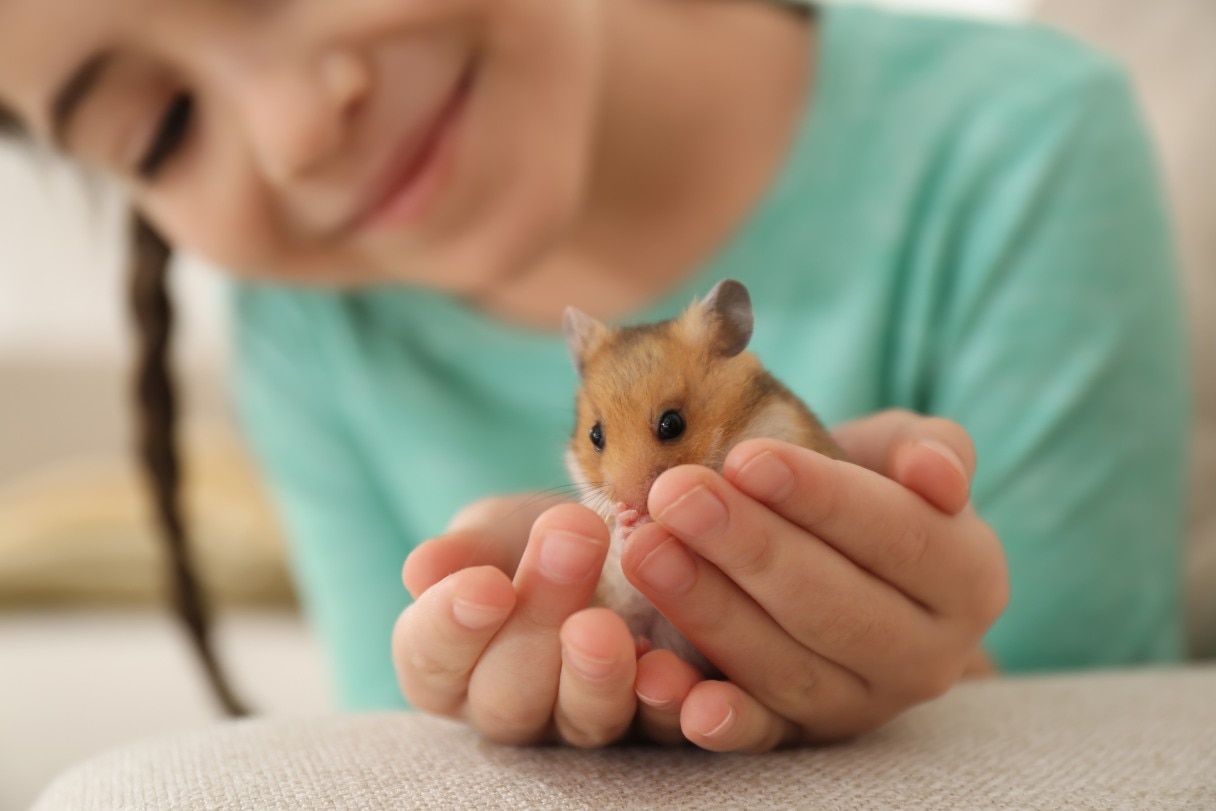The hamster, with its adorable appearance and playful personality, is one of the most popular small pets, especially for families. But while these pocket pets may be tiny, they require just as much care and attention as any other animal.
Whether you're a first-time hamster parent or making sure you’re providing the best care for your current furry friend, this guide will cover everything you need to know. From taking the best care of your hamster, understanding their lifespan and addressing common hamster health issues, you'll be more than ready to keep your hamster happy and healthy.
Different Hamster Species
Hamsters are popular for a reason — these little cuties are known for their stout bodies, short tails and legs and small, furry ears. Their fur ranges in color from gray to reddish-brown, with white to black belly colors. And the Djungarian has a dark stripe down its back.1
Syrian hamsters, also known as teddy bear hamsters or golden hamsters, are the most popular and commonly kept hamsters, typically growing to about 6 inches in length. Smaller, dwarf hamsters — including the Siberian, Roborovski (robo), Djungarian (winter white) and Chinese — are also fairly popular, typically measuring 2 to 3 inches in length.2
How Long Do Hamsters Live?
Pet hamsters typically live two to three years.2 But this can vary depending on the breed, their diet and living conditions, the care they receive and how much exercise they get.3
While their lifespan may seem short, understanding the signs of potential health issues early can help ensure your hamster lives a full and comfortable life.
Common Hamster Health Issues
Among the various health issues hamsters may face, some conditions require particular attention.
Wet tail
Wet tail, another name for hamster diarrhea, is caused by a bacterial infection. It can occur in hamsters of any age and can be life-threatening. The typical treatment involves addressing the electrolyte imbalance and dehydration, administering antibiotics and ensuring your hamster is eating. If the diarrhea continues, your veterinarian may also suggest bismuth subsalicylate.4
Congestive heart failure
Up to 70% of hamsters — typically older ones — will experience atrial thrombosis, often a result of congestive heart failure. Signs of congestive heart failure are rapid breathing, an irregular heart rate and a bluish tint to their skin and/or gums. There is no cure for congestive heart failure, but your veterinarian can help you manage the condition and keep your hamster as comfortable as possible.5
Digestive disorders
Several digestive disorders are common in hamsters, particularly in younger pets who are stressed due to factors such as transportation, overcrowded living conditions, changes in diet or recent surgery or illness. Some of these disorders include:5
Escherichia coli. This infection presents with symptoms similar to other digestive diseases.
Proliferative ileitis. This inflammation of the small intestine can occur as a side effect of antibiotic use.
Protozoa. These organisms are commonly found in healthy hamsters but can cause illness in stressed rodents.
Tapeworms. Tapeworms are typically asymptomatic but in severe cases can cause intestinal inflammation, blockage and infection of the lymph nodes.
Tyzzer disease. Similar to proliferative ileitis, symptoms include loss of appetite, dehydration and watery diarrhea and can lead to sudden death. It is typically caused by ingesting feces contaminated with the bacteria.
Your veterinarian can evaluate a stool sample to diagnose the condition affecting your hamster and prescribe a treatment accordingly.5
Skin diseases
Many skin diseases in hamsters are caused by infections or parasites, including:5
Hair loss (alopecia). Hair loss in hamsters can result from various factors, including inadequate protein in their diets, cage mates chewing on their fur or a type of cancer called T-cell lymphoma.
Ringworm. Caused by a fungus, not a worm, this condition may be asymptomatic or result in bald patches that are crusty and flaky and with red edges.
Skin abscesses. These are infected pockets of pus under the skin, usually from a hamster fighting with cage mates or scraping themselves on something in their cage.
Skin and fur mites. More common in males and older hamsters, mites cause inflammation, along with dry, scaly skin.
Cancer
Only a small percentage of hamsters develop malignant (cancerous) tumors, but lymphoma can occur in older rodents. Most growths on hamsters are benign, but if you notice anything unusual on your pet, call your veterinarian right away. Earlier is better when it comes to treatment.5
Recognizing Health Issues in Your Hamster
As your hamster ages — or even at a younger age — certain signs may indicate that something is wrong. Be on the lookout for these concerning symptoms in your little furry friend:2
Dull eyes
Diarrhea
Hunched posture4
Matted fur
Runny nose
Weight loss
Hamsters are particularly susceptible to respiratory issues and can catch a cold or pneumonia from humans. It's best to avoid handling your hamster when you aren’t feeling well to prevent passing on any illnesses.2
Can I Take My Hamster to the Vet?
Yes! Just like any other pet, if you are concerned about the health of your hamster, you should call the veterinarian. While hamsters don’t get regular vaccines like cats and dogs do, they should be checked regularly by an exotic pet vet who has experience treating rodents.6
Tips to Care for Your Hamster
As with all pets, it's important to take good care of your hamster with a proper diet, ensuring they have access to fresh water and plenty of space and giving them the best care possible.
Proper diet
Many hamsters enjoy a diet that includes a combination of rodent chow (rat blocks) and a seed mix specifically designed for hamsters (look for one made up of pellets, grains, seeds and dried vegetables). It’s also recommended to give your hamster a small amount of fresh fruits and veggies, such as carrots, spinach and apples, two to three times a week. Remove any uneaten food before it spoils, and avoid giving your hamster onions, uncooked beans, chocolate, candy or other junk food.2
Correct hydration
Be sure that your hamster has clean, fresh water at all times. Since hamsters can chew through plastic and even glass, it's best to use a stainless steel sipper tube positioned close to the floor of your hamster’s cage.4
Comfortable home
Hamsters are solitary animals that can be aggressive when housed with others, so if you have multiple hamsters, you’ll need multiple cages. Your pet should be kept indoors in a cage with a solid bottom — the bigger the cage, the better. Give your hamster multiple levels to explore and plenty of places to hide and dig, and be sure the cage has a solid top so your hamster can’t escape. Line the cage with absorbent bedding — not pine or cedar shavings — and remove soiled bedding daily.2
Daily exercise
Hamsters are nocturnal, meaning they are most active at night. Your hamster will likely love an exercise wheel, a plastic igloo and things like paper tubes and PVC pipes. Since hamsters need to chew to keep their teeth healthy, you can provide hamster chews (or an untreated, unpainted piece of hardwood as a suitable alternative).2
Handle your hamster with care
Always handle your hamster gently and avoid waking them up during the day, as they are more likely to bite when startled. Allow your hamster a few days to settle into their new home before offering some small treats. Once they feel comfortable taking treats from you, you can start gently scooping your hamster into your hand. The key is to go slowly and build their trust. Since hamsters don’t have great eyesight, take extra care when handling them outside of their cage to prevent falls or injuries.2
Vet visits
Anytime you are concerned about your hamster’s health, you should consult your veterinarian, especially if you think they’ve reached the end of their lifespan. While it's not always possible to tell that your hamster is nearing the end of their life, there may be some signs:7
Change in behavior
Change in urination or defecation habits
Difficulty breathing
Losing fur
Lumps, masses or tumors
Not being active
Not eating or drinking
Not grooming themselves properly
Shaking or flinching (signs of discomfort, pain or distress)
Small pets rarely hibernate, so if your hamster isn't moving, call your veterinarian right away.7
Hamsters are adorable little pets, and they require care and attention to maintain their well-being. By providing a proper diet, fresh water and a comfortable living space, you can help prevent health problems before they arise, ensuring your hamster lives a healthy and happy life.
CareCredit Credit Card Financing for Pets
Taking good care of your pet's well-being from nose to tail is essential. Make sure to stay up to date on their regular checkups at the vet to help keep your pet happy and healthy for a lifetime of love. You can use your CareCredit credit card for pet care throughout the year for routine veterinary services as well as emergencies and surgeries.* Use our Acceptance Locator to find a veterinarian near you that accepts CareCredit.
CareCredit is there for you and your pet every step of the way; continue your wellness journey by downloading the CareCredit Mobile App to manage your account, find a provider on the go and easily access the Well U blog for more great articles, podcasts and videos.
In addition to pet care, you can also use your CareCredit credit card for dentistry, cosmetic, vision, hearing, health systems, dermatology, pharmacy purchases, spa treatments and so much more within the CareCredit network. How will you invest in your health and wellness next?
Author Bio
Abbie Mood is a freelance writer with more than 15 years of experience. She has worked with clients of all sizes to create compelling content and she has written for the American Kennel Club, Marriott Bonvoy, Women’s Health Online, Headspace and more.








